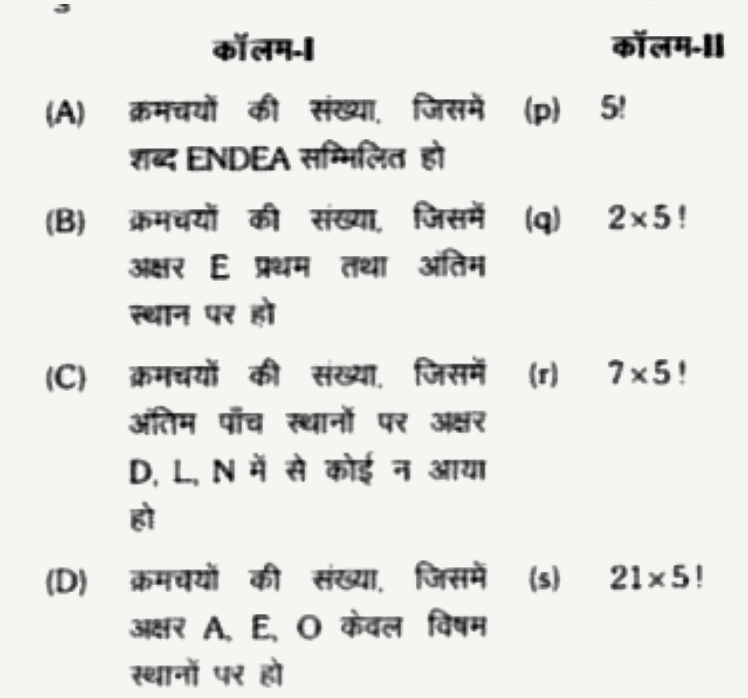यदि समूह की संख्याओं x1,x2,x3,….xn का माध्य ¯x हैं, तब संख्याओं xi+2i,1≤I≤n का माध्य है
¯x+2n
¯x+n+1
¯x+2
¯x+n
The correct Answer is:B
Step by step video, text & image solution for यदि समूह की संख्याओं x_1,x_2,x_3,….x_n का माध्य barx हैं, तब संख्याओं x_i+2i,1 le I le n का माध्य है by Maths experts to help you in doubts & scoring excellent marks in Class 12 exams.
Topper's Solved these Questions
- BOOK - ERRORLESS HINDICHAPTER - केन्द्रीय प्रवृत्ति के मापEXERCISE - Jee Advanced (Reasoning )2videos
केन्द्रीय प्रवृत्ति के माप
- BOOK - ERRORLESS HINDICHAPTER - केन्द्रीय प्रवृत्ति के मापEXERCISE - Solved Multiple Choice (विक्षेपण की माप)30videos
केन्द्रीय प्रवृत्ति के माप
- BOOK - ERRORLESS HINDICHAPTER - अवकलन तथा अवकलज के अनुप्रयोगEXERCISE - JEE Advanced (Matrix Match type questions)22videos
अवकलन तथा अवकलज के अनुप्रयोग
- BOOK - ERRORLESS HINDICHAPTER - क्रमचय एवं संचय EXERCISE - Jee Advanced (Matrix Match questions )4videos
क्रमचय एवं संचय
Similar Questions
कथन - 1 : प्रथम n सम धन पूर्णांकों का प्रसरण n2−14 है।
कथन - 2 : प्रथम n धन पूर्णाको का योगफल n(n+1)2 और प्रथम n धन पूर्णांको के वर्गों का योगफल n(n+1)(2n+1)6 है।03:37View Solutionविक्षेपण की माप है
01:44View Solutionकॉलम I में दिये गये वक्तव्यों का कॉलम II में दिये अंतरालों अथवा अंतरालों के सम्मिलन से सुमेल करें
कॉलम -Iकॉलम - II(A)समुच्चय{Re(2iz1−z2):zएकसम्मिश्र संख्या है|z|=1,z≠±1}है(p)(−∞,−1)∪(1,∞)(B)फलनf(x)=sin−1(8(3)x−21−32(x−1))का प्रान्त है(q)(−∞,0)∪(0,∞)(C)यदिf(θ)=∣∣ ∣∣1tanθ1−tanθ1tanθ−1−tanθ1∣∣ ∣∣,तब समुच्चय{f(θ):0≤θ<π2}है(r)[2,∞)(D)यदिf(x)=x3/2(3x−10),x≥0,तबf(x)किसमे वर्धमान है(s)(−∞,−1]∪[1,∞)(t)(−∞,0]∪[2,∞)03:16View Solutionशब्द ENDEANOEL के अक्षरों के सभी संभावित क्रमचय को मान्य करना है।
कॉलम I में दिए गए वक्तव्यों का कॉलम II में दिये गये मानों से सुमेल करें
 02:15View Solution
02:15View Solutionमाना दो धनात्मक संख्याओं के हरात्मक माध्य और गुणोत्तर माध्य का अनुपात 4:5 है। तब दोनों संख्याओं का अनुपात.........होगा।
04:49View Solutionयदि a व 2a का समांतर माध्य इनके हरात्मक माध्य से 2 अधिक है। तब a का मान है
04:18View Solutionसंख्याओं 3,32,33,...3n का गुणोत्तर माध्य ज्ञात कीजिए।
02:16View SolutionIf the mean of the set of numbers x1,x2,x3,...,xn is ¯x, then the mean of the numbers xi+2i,1≤i≤n is
02:04View SolutionIf the mean of n observation ax1,ax2,ax3,,axn is a¯¯¯X , show that (ax1−a¯¯¯X)+(ax2−a¯¯¯X)++(axn−a¯¯¯X)=0
04:08View Solutionx1,x2,x3,……….,xn are n observations . n∑i=1(xi−2)=100 and n∑i=1(xi−5)=20 then mean ¯x = …….
02:15View Solutionx1,x2,x3,….xn then (x1−¯x)+(x2−¯x)+(xn−¯x)=0.
02:01View Solutionयदि n संख्याओं x1,x2,x3,.....,xn का समान्तर माध्य x हो, तो n∑i=1(xi−x)=?
01:38View SolutionIf the mean of observationsx1.x2,x3…..xnis¯x then the mean of x1+a,x2+a,…...xn+a will be
03:32View SolutionIf ¯x is the mean of a set of n observations x1,x2,x3…..,xn then n∑i=1(xi−¯x) is equal to
02:27View SolutionIf the mean of the numbers x1,x2,x3,….xn is ¯x, then the mean of the numbers xi+2, is , where 1 ≤i≤n
02:05View Solution

